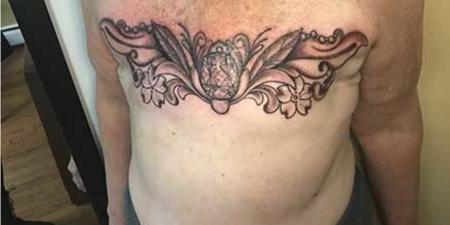Abstract
Advertising a plastic surgery practice on social media is fraught with both practical and ethical challenges. We use an institutional betrayal framework to explore the range of potential harms to patient well-being while also considering the pitfalls of social media activity, especially marketing, for practitioners. We also give consideration to the relative benefits that such online patient-clinician relationships can provide. In our analysis, we draw on specific examples of plastic surgery procedures prominently featured on social media, including the Vampire Facelift®.
Narrative of a “Vampire” Patient
J was scrolling through social media during a lunch break and stopped at a post of side-by-side pictures of a woman’s face labeled “Before and After,” with the latter photo showing the woman’s skin looking smoother and more luminous. But the caption was what really caught J’s attention: “Kim Kardashian’s Anti-Aging Secret: the Vampire Facelift®!” The post had been shared by a friend who J knew loved the Kardashian celebrity empire, but the original picture had been posted by a fancy downtown spa.
J had recently been considering some sort of cosmetic procedure. J thought he looked tired, even after a full night’s sleep, and was worried about the effect that years of running outside in the sun had inscribed on his face. Every day, he experienced some version of the thought that he didn’t look as young as his 42 years. J clicked on the page of the spa and noticed it had recently published several posts about the technology and science behind the procedure. J looked at several illustrations that showed the procedure: a minor blood draw, a centrifuge machine, and tiny facial injections. There were even videos made by a cosmetic surgeon, Dr. A, who explained how the Vampire Facelift worked. She spoke casually, joking about the spooky name that arose from the use of patients’ own plasma, which was injected with microneedles to stimulate the skin’s own regenerative properties. She then described the medical technology that made the procedure effective and the healing process quick.
Dr. A seemed warm and knowledgeable; J felt growing comfort that she personally cared about the safety of the procedure. While it all sounded a little weird, J relied upon Dr. A as a certified plastic surgeon who seemed confidently to emphasize that the procedure was based on the latest evidence-based scientific innovations. Later that night, he went back to the social media page and read comments on all the posts; they uniformly conveyed positive experiences about this procedure, and some offered rave reviews of Dr. A’s skill and persona and even posted pictures of postprocedure results. J noticed some common friends among those who had commented. The procedure seemed low risk, and there was even a special going on through the month of October—a “Halloween sale” for the Vampire Facelift. J took a deep breath and called the spa clinic to make an appointment.
Practical and Ethical Considerations of Implying Brand Innovation on Social Media
As we see in the above vignette, advertising via social media allows patients to develop a personal connection to a practice before they enter the physician’s office. Many patients take advantage of this source of information; indeed, one study found that 70 percent of people seeking to inform themselves about plastic surgery abroad relied on the internet as their main source of information and also cited the quality of the surgeon’s website as the most powerful influence on their choice of plastic surgeon.1 Although an online “relationship” can help foster rapport by building a sense of familiarity or even trust before an in-person meeting, as we see above, it can also disrupt the normal “cautious consumer” behavior and decision making of prospective patients. Patients’ general trust in medicine or in the reputation of a specific practice can extend to unknown physicians, allowing patients to overlook a lack of specific information about these physicians’ trustworthiness or competence.2 Indeed, a recent survey of US plastic surgery practices’ websites found that only 40 percent describe potential complications of procedures.1 When this trust is not borne out—when the procedure does not live up to heightened expectations or complications arise—patients can feel betrayed not just by the physician but by the “brand” the physician has built (and even by the field of plastic surgery writ large)—a phenomenon recognized as institutional betrayal.2-4 Thus, it behooves physicians to consider the likely effect of common social media practices through an ethical lens.
In this paper, we will discuss the ethical issues introduced in the vignette and how they are uniquely heightened in the context of social media advertising and branding. Throughout, we focus on the added complication of protecting patients’ trust in this new landscape: how it can be built, maintained, or “institutionally betrayed” by unethical social media practices.
Potential for Deception in Social Media Advertising
At present, there are no restrictions on advertising in medicine except when it can be specifically justified as necessary to protect the public from deceptive (i.e., intentionally misleading) practices.5 That deception rather than mere inaccuracy (i.e., inadvertent misinformation) is the crux of this ethical guideline illustrates the need to protect patients’ trust given the imbalance of power and knowledge in the patient-physician relationship. As the case example above illustrates, deceptive advertising restrictions can become quite ambiguous in a social media environment, and J’s social media research exposes him to at least two potentially deceptive practices.
The first is presenting the Vampire Facelift treatment as an innovative and exclusive procedure through description, capitalization, and use of a trademark. Given ethical imperatives to share medical advances,5 it is unlikely that Dr. A is the only plastic surgeon offering this type of treatment. However, she uses branding techniques to suggest that the treatment is exclusive and thus potentially scarce, particularly by referring to the “latest” technology and calling the treatment a celebrity’s “anti-aging secret.” Invoking the image of a beautiful celebrity to drive demand for a surgical procedure can create a particular type of vulnerability for patients. Besides unfairly anchoring patient expectations in the idealized image of a global celebrity, the message that patients’ appearance is damaged and can only be repaired by experts using highly specialized techniques means that patients who internalize that message start to evaluate the work of those experts from a disempowered position. Feminist scholarship has described this dynamic as infiltrated consciousness, the idea that a member of an oppressed group “endorses, as part of her self-concept, a dominant group’s dismissive or exploitative understanding of her group, and loses or fails to acquire a sense of herself as worthy of full moral respect.”6 In the context of social media, such a notion can deepen our understanding of why it is problematic that prospective patients are subjected to plastic surgeons’ social media advertising premised on fixing “damaged identities,”6 as expressed in their appearance.
The second potentially deceptive practice in this case relates to the public testimonials that assure a particular outcome. J was swayed by the uniformity of the opinions expressed on the spa’s social media page. Personal endorsement is a powerful influencer of human behavior,1 and it can be leveraged to deceptive effect on social media. The AMA Code of Medical Ethics stipulates that testimonials of patients as to a physician’s skill or the quality of his or her professional services should “reflect the results that patients with conditions comparable to the testimoniant’s condition generally receive.”5 However, on social media, comments and testimonials can be carefully curated; negative comments can be removed surreptitiously and people can be asked, persuaded, coerced, or otherwise incentivized (perhaps even paid) to leave positive comments. Increasingly, medical institutions are hiring administrative personnel to manage institutional social media accounts.7 This practice can lead not only to inaccurate or deceptive curation of user comments but also to improper interactions with patients (e.g., inadvertently revealing private health information.)1
How Social Media Can Facilitate Institutional Betrayal
Patients seeking information about a surgical procedure are exposed to social media practices used to create “branded” accounts (i.e., those replete with compelling posts, pictures, and videos showing a means to accomplish a dearly desired outcome). In J’s case, a well-captioned picture caught his attention, and he was swayed by multiple sources of information on one of the spa’s social media pages. Brands build and sustain trust by increasing consumers’ perceived product knowledge (including effectiveness and value)8 and by their representatives being “responsive” to consumers (e.g., replying to comments, following up with complaints, and checking on customer satisfaction.)9 Social media might inflate prospective patients’ sense of their knowledge of or confidence about a given procedure (via videos, simplistic infographics, others’ testimonies, assurances from operating team, and so on) while not actually increasing their understanding of how the procedure would work for them or the risks involved. Such practices create the conditions under which patients are more likely to be exposed to harm without their knowledge of this increased risk and are antecedent to institutional betrayal.
Moreover, social media can create a false sense of familiarity for prospective patients like James, who build their trust in a practice’s or physician’s brand based on cues usually reserved for a patient-physician relationship. These include perceptions of a physician’s competency and fiduciary responsibility (i.e., protecting the patient’s best interests), which are usually based on observable behaviors that occur within an existing relationship.3, 10 In contrast to relying on their interactions with physicians for relevant cues, prospective patients look to online reviews to infer the trustworthiness of physicians (as J did), and these selectively presented reviews tend to skew positive for plastic surgeons and increase patient perceptions of their competence.11 Even if reviews are mixed, patients in a vulnerable state may be inclined to cherry-pick positive comments, effectively seeing what they want to see, especially in informal media that encourage rapid consumption of massive amounts of visual, textual, and other data.
Patients can feel betrayed if something goes wrong or if the procedure simply isn’t as effective or seamless as they had hoped (both common precursors to lawsuits.)12 However, because their relationship with a surgeon known mainly through social media is not actually close, this betrayal can manifest in potentially harmful and difficult-to-resolve ways—e.g., withdrawing from follow-up care, negative social media engagement, or self-recrimination.12
Risks and Benefits of Connecting with Patients Online
Risks. Prospective patients who are, like J, distressed due to dissatisfaction with their bodies and seeking help from a place of vulnerability might develop a sense of trust in a physician or medical practice based on a false intimacy that can occur on social media.13 Patients might look to signals of competency such as describing oneself as a “cosmetic surgeon,” providing sanguine testimonials from previous patients, associating one’s work with a celebrity, promoting “exclusive” practices, using scientific language or images to communicate the precision or effectiveness of a procedure, curating a sizable online following, or demonstrating a particular charm or charisma in online postings. Indeed, stylistic and aesthetic factors extraneous to medical practice (e.g., how well-made the social media account page appears or how familiar the platform is to the user)13 can contribute to trust, thus serving as potential factors in retrospective feelings of betrayal. This trust, combined with signals about the scientific rigor of “innovative” treatments and access to videos or other materials that show portions of a procedure or before-and-after pictures, might lead prospective patients to undertake a procedure with inflated expectations, setting up both patient and physician for the difficult task of managing disappointment.
Benefits. Physicians productively engaging with patients on social media (e.g., honestly and openly answering questions, sharing success stories with patient permission) can be a powerful way of transparently demonstrating how a practice does medicine and what reasonable expectations might be associated with particular clinical treatments. A social media account can offer a physician a means of serving as a thought leader and of offering and disseminating information about prevention, self-care, and so on to a wider audience, irrespective of whether the consumers of that information eventually become paying consumers of services. It can also be used to counter nonevidence-based advertisements, debunk sham science, or share new scientific innovations along with contextual information. For instance, in the vignette above, Dr. A could use her engaging video presence to explain the risks and benefits of different procedures or even to share scientific information that does not directly benefit her business. One real-life example of this approach is how a plastic and reconstructive surgeon in Atlanta uses social media to share research and education materials on different procedures, advice on how to know if a procedure or surgeon is right for a particular patient, and information on the intersection between plastic surgery and other areas of medicine (e.g., reconstructive breast surgery following a mastectomy.)14 The main goal of these videos is to objectively educate followers rather than generate business.
Conclusion
Having become a nearly ubiquitous global presence within the past decade, social media is a problematic new ecosystem that can foster deceptive professional behavior. It exists outside the internally protected confines of the peer-reviewed literature; lacks institutional or other regulatory oversight; encourages informality; and provides a format that makes allowances for hype, hyperbole, and valorization of style over substance that don’t mesh well with the highly regimented standards of medical practice and can create false expectations for viewers. Many lay users of social media might lack the capacity for critical appraisal of medical claims about true innovation and effectiveness, particularly those who are vulnerable and seeking out answers they want to find. Such users bring credulity, trustworthiness, and hope to the social media presence of medical clinicians, particularly when there is a carefully curated professional presentation, as in the case above.
Emerging generations of patients are likely to continue seeking out social media platforms for health information and a sense of deeper connection to their clinicians.15 Although they are likely to be social media savvy, both they and physicians are susceptible to traps related to the quest for human connection in a digital world. With caution and probity, the platform afforded by social media can be used to elevate and protect the science of plastic surgery and safeguard the trust of patients.
References
- Nassab R, Navsaria H, Myers S, Frame J. Online marketing strategies of plastic surgeons and clinics: a comparative study of the United Kingdom and the United States. Aesthet Surg J. 2011;31(5):566-571.
- Mechanic D. The functions and limitations of trust in the provision of medical care. J Health Polit Policy Law. 1998;23(4):661-686.
-
Smith CP. First, do no harm: institutional betrayal and trust in health care organizations. J Multidiscip Healthc. 2017;10:133-144.
- Smith CP, Freyd JJ. Institutional betrayal. Am Psychol. 2014;69(6):575-587.
-
American Medical Association. Opinion 9.6.1 Advertising and publicity. Code of Medical Ethics. https://www.ama-assn.org/delivering-care/advertising-publicity. Accessed February 23, 2018.
-
Lindemann H. Damaged Identities, Narrative Repair. Ithaca, NY: Cornell University Press; 2001:xii.
- George DR, Kime L, Riley T. How are healthcare institutions using Facebook to interact with online communities? Results from a case study in Central Pennsylvania. J Hosp Admin. 2015;4(3):89-92.
-
Habibi MR, Laroche M, Richard M. The roles of brand community and community engagement in building brand trust on social media. Comput Human Behav. 2014;37:152-161.
- Laroche M, Habibi MR, Richard M, Sankaranarayanan R. The effects of social media based brand communities on brand community markers, value creation practices, brand trust and brand loyalty. Comput Human Behav. 2012;28(5):1755-1767.
-
Mollborn S, Stepanikova I, Cook KS. Delayed care and unmet needs among health care system users: When does fiduciary trust in a physician matter? Health Serv Res. 2005;40(6)(pt 1):1898-1917.
- Wogalter MS, Mayhorn CB. Trusting the internet: cues affecting perceived credibility. Int J Technol Hum Interact. 2008;4(1):75-93.
-
Menon AV. Do online reviews diminish physician authority? The case of cosmetic surgery in the US. Soc Sci Med. 2017;181:1-8.
- Gorney M. Ten years’ experience in aesthetic surgery malpractice claims. Aesthet Surg J. 2001;21(6):569-571.
-
Facebook. Allyson Maske, MD—plastic and reconstructive surgeon. https://www.facebook.com/DrAllysonMaske/. Accessed November 16, 2017.
- Lober WB, Flowers JL. Consumer empowerment in health care amid the internet and social media. Semin Oncol Nurs. 2011;27(3):169-182.



